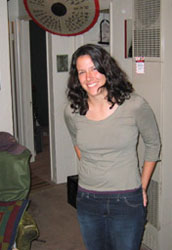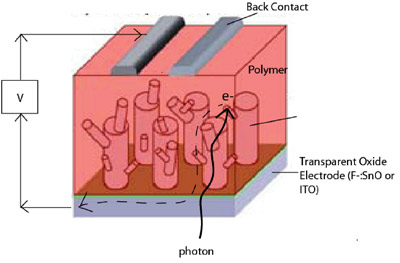
Sara York



Figure 1: Proposed solar cell. Light energy
(photon) enters through the transparent layer, passing through the metal
oxide and into the polymer where an electron is excited. The excited
electron is then passed into the lower energy metal oxide and conducted
into an external circuit where voltage is collected. The remaining
electron vacancy or hole then diffuses toward the back contact where
it is replenished with a low energy electron. (Adapted from D.T.
Schwartz et.al. NIRT proposal)
People - Students - Cohort 1 - Sara York
Sara York
Education: BS, Chemical Engineering 2005 Oregon
State
Major: Chemical Engineering
Advisor: Dan Schwartz
Major research project: Production of hybrid inorganic-organic photovoltaic cells via protein-seeded solution processing
As the cost and demand for energy rise, so does the need for alternatives to traditional power generation. Among the alternatives, solar power is promising since it harnesses energy the earth receives passively. Currently there are two main drivers in solar energy development: efficiency and cost. These two forces conflict since high efficiency cells require high material purity and thus more processing, which increases cost. Meanwhile, a less expensive cell generally undergoes less processing, which usually results in lower efficiency.
There is also a third driver, environmental impact, that should be evaluated. In general, a “green” energy implicitly has lower harmful emissions of production, use and disposal than those of fossil fuels. Although using fossil fuel as the standard to beat is a good starting point, but there are also differences between “green” sources. As more people employ alternative energies, the impact of production, use and disposal increases.
Therefore the overall goal of this research is to balance cost, efficiency and environmental impact of a solution processed solar cell. To accomplish this, my research can be broken into two main areas: design and life cycle evaluation. The first is to design an inorganic-organic photovoltaic cell via solution processing which will reduce energy input and production cost, Figure 1. To reduce production energy input we are focusing on a new nanomanufacturing technique that uses proteins to produce specific inorganic structures (such as ZnO). In this process, an appropriate inorganic synthesizing polypeptide (ISP) is patterned on a surface. The ISP is chosen for its ability to control the nucleation, growth rate and crystallinity of the desired inorganic. The seeded plate is then introduced into an aqueous electrolyte solution where an inorganic substrate of controlled crystallinity forms. A conducting organic, such as poly(3-hexylthiophene), will be used as the photon accepting layer (where electron excitation occurs) because organics also have the benefit of being solution processable. For more information, please see the Schwartz group webpage, http://depts.washington.edu/emilab/index.html
The second focus is life cycle analysis (LCA), which is a method of comparing the cradle to cradle emissions and energy consumption of different products. Commercial solar cells have already shown lower lifetime emissions than fossil fuel energy (primarily due to combustion of fossil fuels) through LCA (M. Raugei et al., 2006). There is also a difference between cells, and photovoltaic cell design improvement should include not only increased efficiency, but reduced environmental impact.
In summary, what we are working towards is expanding the range of available
solar devices. In addition to lower production costs, solution processable
cells have the advantage of flexible application. This means that they
could be coated onto a variety of surfaces- large or small, flat or
curved. Ultimately this means that economic solar energy could be available
not just on roof tops, windows and other rigid applications, but in
car paints, flexible materials and in hand-held devices.
(See left for Figure 1)

